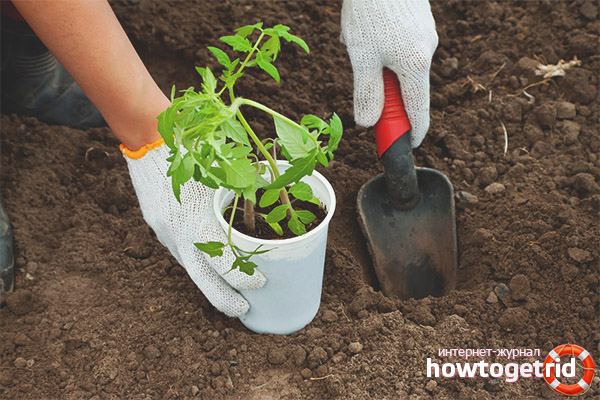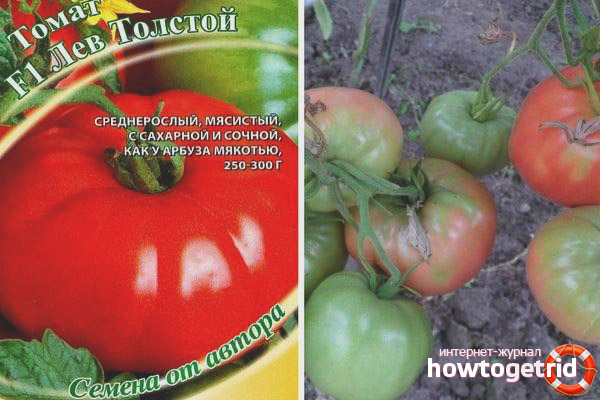The content of the article
“Leo Tolstoy” is a hybrid created for lovers of delicious tomatoes. It can be grown both in greenhouses and in open soil under warming. Tomato fruits have a rich color and taste. Harvested vegetables can be eaten fresh, or you can prepare juice, sauce or puree.
Description
The variety was created by crossing different species, bred for the possibility of cultivation in any region. Tomatoes need heat, so it’s best to plant the plant in greenhouses. If climatic conditions allow, plant in the soil under the film. The torn fruit is stored for a long time and easily tolerates transportation. If you pick a tomato during technical ripeness, it easily ripens in the sun.
The hybrid was bred in the first generation, which is why it is unpretentious to living conditions. The bushes of the plant are similar in size, the maximum height is 130 cm. The tomato is compact, when growing it is not necessary to tie and pinch. Greens grows on the bush evenly and in small quantities. The plant begins to be fruitful early, about 110 days after planting. One bush at a time can bestow 3 kilograms of tomatoes.
Positive and negative sides
Positive aspects of Leo Tolstoy's landing:
- Good fruiting.
- The fruit has a subtle aroma and juicy fleshy structure.
- The taste is sweet and pleasant.
- Seldom picks up the diseases characteristic for nightshade.
- Resistant to sudden changes in temperature.
- The bush does not grow to enormous size, so it is not necessary to tie and pinch the plant.
Negative parties are many times less. Many gardeners know that if the plant is not comfortable with climatic conditions and soil conditions, there will be few ovaries. The variety is very sensitive to soil nutrition.
The main characteristics of the fruit:
- The average size. The largest tomatoes (up to 0.5 kg) are harvested from the first harvest. During the next harvest, the size of the tomato will reach 0.2 kg.
- The fruit ripens only at the end of the season.
- A ripe vegetable of a bright red hue, has a flat round shape.
- The skin of the fetus is dense enough to keep the flesh from cracking.
- The tomato contains about 5 chambers. The structure is juicy, sweet aftertaste.
- The pulp has a rich taste. Many note that the taste is similar to a sweet watermelon.
- The fruit is low-calorie, contains few sugars and beta-carotene. Therefore, it can be consumed by children and losing weight.
The variety is often used for the preparation of salads, side dishes, hot dishes, tomato purees and juices. A ripe fruit will produce a very thick juice with a sweet aftertaste. Such tomato juice will be appreciated by everyone, including children.
Landing Features

For seedlings in small pots, seeds need to be planted in early spring. The soil should not be heavy and have an acidic environment. The best option for such a tomato is turf and garden soil with humus and other neutral fertilizers.
Important! The soil must be loose, so it is necessary to add river sand and vermiculite to it. The soil must also be nutritious, and superphosphate and wood ash will help in this.
Before planting the seeds, they must be decontaminated using a solution of hydrogen peroxide. Next, soak in a growth stimulator for 10 hours. After all operations, they must be dried and seeded into a 1.5 cm recess, covered with a film.
The sprout will grow best at 25 degrees. After the appearance of small processes, it is necessary to move the seedlings to a bright place. This can be a window sill under the sun, or a place under a good quality electric lamp.When more than 3 leaves appear on a seedling, it must be distributed in a separate container.
Important! If you do not have a greenhouse, you need to prepare a seedling for harsh living conditions in open ground, i.e. temper. Sometimes they need to be taken outside, each time increasing the time spent outside the heat. If you have a warm day, take the seedling out into the open air for the whole day.
Next, you need to plant the plant in a kidney or a greenhouse. Landing occurs in late May or early June. The soil must be well plowed up and potassium-phosphorus humus or wood ash added to the wells. One bush takes about 1 tablespoon. The distance between the bushes is 40 cm, between the rows - 60 cm. We plant and enrich the plant with nutrients and warm water.
Video: how often and how much to water tomatoes?










Submit